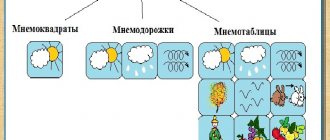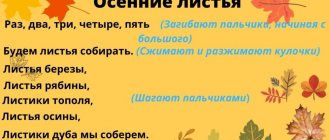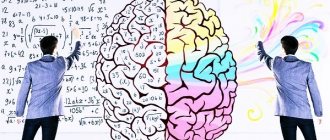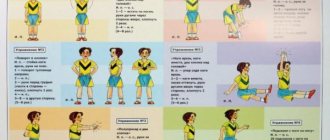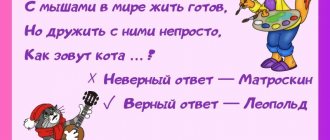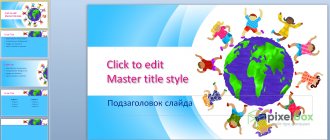Presentations
The Rainbow presentation is based on a mnemonic technique for remembering something. This presentation will help your child remember the colors of the rainbow, which appear in a certain order.
Presentation “BALLS ” (with sound). On the slides you will see different balls with their names (can be used for reading according to Doman, the name and picture are on different slides). Presentation of “PYRAMIDS” (without sound). The child will learn what types of pyramids there are (picture of the pyramid and name).
FIGURES AND FORMS
Presentation “Pentagon” (with sound). Children will learn which objects are similar to a pentagon. Presentation “Heart” (with sound). What is heart shaped? Presentation “Trapezoid” (with sound). What objects are shaped like a trapezoid? What in living nature is similar to a trapezoid? Presentation “Star” (with sound). What is a star shape? Presentation “Fun Geometry” (with sound). Children will see which objects, plants, vegetables, fruits and even animals are similar to geometric shapes. The presentation included: circle, triangle, square, oval, rectangle, rhombus, star, heart, trapezoid, pentagon.
PUZZLES
Presentation “RIDDLES ABOUT MUSHROOMS” (with sound). First, the child sees and hears the text of the riddle, then the answer follows (a close-up picture of a mushroom and its name). Presentation “NEW YEAR’S RIDDLES” (with sound and animation). RIDDLES: “VEGETABLES IN THE BED” (with sound and animation). Riddles about: cabbage, carrots, cucumber, radish, pepper, eggplant, onion, tomato, potato, corn, beans, radish, melon. RIDDLES “FRUIT” (with sound and animation). Kids will guess about: orange, apple, banana, pear, pineapple, pomegranate, lemon, kiwi, peach, persimmon, plum, avocado, apricot. RIDDLES “BERRIES” (with sound and animation). Berries: raspberries, black currants, grapes, cherries, sea buckthorn, watermelon, blackberries, cherries, blueberries, gooseberries, strawberries, rose hips, cranberries. “PETS” RIDDLES (with sound and animation). Children will guess about: kitten, hen, puppy, goat, rooster, chicken, turkey, duckling, cow, rabbit, horse, sheep, pig, goose. RIDDLES “WILD ANIMALS” (with sound and animation). Wild animals: deer, bear, chipmunk, tiger, raccoon, fox, hedgehog, wolf, beavers, lynx, squirrel, hare, mole, wild boar. RIDDLES “ANIMALS OF FAR LANDS” (with sound and animation). We will guess about: kangaroo, koala, lion, zebra, panda, panther, monkey, rhinoceros, crocodile, hippopotamus, elephant, platypus, giraffe, whale, anteater. RIDDLES ABOUT VEGETABLES (no sound). You will guess riddles about: peas, tomatoes, onions, carrots, peppers, cabbage, cucumbers, beets, potatoes. RIDDLES ABOUT PLANTS (without sound). We guess about: bell, sunflower, chamomile, iris, carnation, lily of the valley, as well as about a Christmas tree and a forest.
SEASONS
FOLK SIGNS IN WINTER (with sound) . The child will learn about signs associated with animals, plants and even smoke from a chimney. NATURAL PHENOMENA IN WINTER (with sound). The child will see a picture and information on the following phenomena: snow, frost, frost patterns, snowfall, freeze-up, blizzard, snowdrift, frost, thaw, ice, icicle, northern lights, snowballs. Presentation “LET’S GO FOR A WALK IN THE STREET. WINTER." (with sound). From the presentation, the child will learn what games can be played outside in winter. FOLK SIGNS OF SPRING (with sound). Signs about icicles, birds, fogs, flowers and animals. NATURAL PHENOMENA IN SPRING (with sound). What spring natural phenomena do you know? Melting snow, spring ice drift, thawed patches, floods, drops, first flowers - you will learn about all this in the presentation. FOLK SIGNS IN SUMMER (with sound). Folk signs about mosquitoes, fish, sunset, dew, bees, berries, fogs, frogs, swallows, dragonflies, bubbles in puddles, dandelions and others. NATURAL PHENOMENA IN SUMMER (with sound). Natural phenomena: birdsong, summer solstice, ripening berries, thunderstorm, rainbow, blind rain, hail, dew... FOLK SIGNS IN AUTUMN (with sound). Signs about leaves, ants, rain, trees, fog, mushrooms, clouds, pine cones and stars. NATURAL PHENOMENA IN AUTUMN (with sound). These include: the day of the autumn equinox, leaf fall, harvest of fruits and vegetables, migration of birds for the winter, preparation of animals for winter, autumn freeze-up.
ANIMALS
ANIMALS OF THE NORTH part 1 (with sound). The presentation contains not only images of animals, but also the sounds that you will hear from each animal. Animals : polar bear, penguins, seal, albatross, arctic fox, bighorn sheep, polar owl, reindeer, walrus, loon, musk ox. ANIMALS OF THE NORTH part 2 (with sound). Continuation of the first presentation about animals of the north. You will see and hear animals: fur seal, arctic wolf, arctic tern, mountain hare, lemming, ermine, saiga, ptarmigan, squirrel, lynx, beluga whale.
HOLIDAYS Presentation “EASTER” (with sound and animation).
VICTORY DAY MAY 9TH THE GREAT PATRIOTIC WAR IN PAINTINGS BY ARTISTS (24 paintings in pdf format, which you can print and show to children.) Presentation “St. George’s RIBBON” (pdf format). From the presentation you will learn what the “St. George Ribbon” is, which symbolizes how to wear it correctly.
What presentations are suitable for children of primary preschool age?
Maisat A.Z.
What presentations are suitable for children of primary preschool age?
MUNICIPAL BUDGET
PRESCHOOL EDUCATIONAL INSTITUTION
KINDERGARTEN No. 8 “THE LITTLE MERMAID”
Kstovo 3 microdistrict building 27 telephone 2-11-93, 2-27-16, 2-17-31
What presentations are suitable for young children??
Developed by the teacher:
Second Jr. groups,
Abdullaeva M.Z.
Kstovo
2020
Presentations for younger groups:
Let's look specifically at presentations for nursery groups ; the little ones are now taught this way too!
• 1 What is the essence of working with presentations ?
• 2 What presentations are suitable for young children??
2.1 By the way, I recommend reading:
• 3 My achievements from past years!
• 4 If you want to increase your child’s self-esteem, play with him!
• 5 Let me start educating myself!
What is the essence of working with presentations ?
of presentations during the school year , both for children and parents, which can be shown to them at a meeting. For example, I made a presentation on routine moments for young children . They really liked that the information was presented not only verbally, but also visually. This is also very convenient because such a presentation can then be sent to parents by email, and they will not have to sit and take notes with a pen instead of watching and listening.
As for the work of educators themselves, they must choose during the year a certain direction of the project in which they will work. Themes can be very different, but for the nursery group of a kindergarten it is better to choose light and interesting themes that will be appropriate for this age , for example, colors, animals, favorite toys, etc.
At the end of the school year, as a rule, in May, a final meeting is held in the kindergarten, during which the teacher tells parents about the successes of their children, and also talks about his activities over the past year. A nursery group report is prepared in advance, which also indicates the number of presentations on topics for students and their parents. The teacher can also introduce some data from the analytical report to parents.
If you are a good teacher, an attentive educator, but are completely far from these technical issues, including the use of ICT technologies, then you can find good ready-made options.
What presentations are suitable for young children??
In a nursery group, it is difficult to keep children’s for a long time on the same activity, and looking at a screen for a long time at this age is quite harmful , so the main rule of creating a presentation for kids is brevity, colorfulness and accessibility.
In other words, it should be short, bright and beautiful, and with its help the child should get acquainted with the information that this presentation carries and assimilate this information.
I offer an example of a colorful presentation on the topic “Wild Animals”
. It is relatively small, but at the same time voluminous in content: children get acquainted with wild animals that live not only in our area, but also in other regions and continents, and also learn short poems along the way.
Or here’s some interesting material about the most common colors for babies. The image of objects of a specific color will allow you to visually reinforce the material, and with the help of poems you can also perceive the information aurally. Usually this combination in training gives very good results.
As for the selection for parent meetings, I recommend paying attention to the methodological development “Adaptation of toddlers ”
, because more than half of the kids are faced with adapting to kindergarten, especially at such a young
age , and parents are most often at a loss and don’t know how to help the baby.
I hope that the information offered will be useful to you, my dear novice educators. I was glad to help you, and you can help your colleagues - share this article
